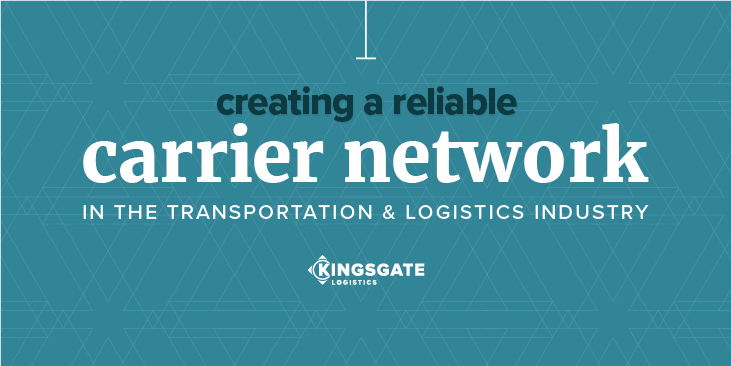
Building a reliable carrier network in the transportation and logistics industry
April 19 2022In the transportation and logistics industry, no one works alone. Shippers, carriers, brokers and everyone in between are bound to create relationships for their operations to run smoothly.
Carriers are one of the most critical parts of the entire transportation process since they transport the much-needed goods. Understanding their importance is vital, but here’s where most of the issues stem.
Companies within the transportation and logistics industry must build a solid carrier network to provide the best services possible to their clients. The first step to doing so is accepting the need for a robust work relationship.
How to build a carrier network in the transportation and logistics industry?
From the very beginning, when your business starts getting those first loads from customers, you need to start creating that relationship with carriers.
To do so, you’ll need to understand the industry’s market and rates. You must have a little empathy and a lot of patience since building relationships takes time and effort.
Finding the right carriers
One of the first things is to find suitable carriers to transport your customers’ freight
H4: Where to find carriers?
There are many ways to find top carriers. Let’s talk about a few.
Load boards
Even though load boards are mostly known for providing same-day loads, they are also a great hunting ground for carriers. Here, you may create these necessary relationships by asking the right questions and getting to know more about the carrier.
With more information about them, you’ll be able to use their services on other occasions. Instead of becoming a transactional relationship, make it into a long-term work relationship.
Data bases
The Federal Motor Carrier Safety Association is a great resource to find carriers. Even though the information is not updated in many cases, it’s an excellent way to start. It’s essential to look for other options in other carrier sourcing databases which are up-to-date and vetted.
Referrals
One of the most well-known systems to find new carriers is referrals. To start your referral network, you’ll just need to ask your current clients to refer your services to other carriers until you are able to create a larger carrier base.
Essential tips to build long-lasting carrier relationships
These are just some of the ways you may start to create your network. But it’s also essential to consider the following tips to build a strong and long-lasting relationship with your carriers. At the end of the day, your brokerage is only as good as the carrier network you can build. Let’s discuss a few.
Accept the importance of a robust carrier network.
As we have mentioned, carriers are an essential part of the process. It’s crucial to accept the importance of carrier relationships since they are in charge of moving freight. Ask yourselves, if there’s not a good relationship, why would they want to move your freight faster? Or work with you?
Make sure to nurture the relationship, and you’ll be well on your way to a streamlined transportation process.
Do not make empty promises.
We all know that many promises are made when selling or recommending a service; it’s part of the process. But one of the main reasons customers get disillusioned with your services is when these promises are empty or untruthful.
Therefore, if you’re trying to build a relationship that’s based on trust, one of the essential parts of the process is avoiding overpromising and underdelivering. Instead, make sure to understand their needs and how you can provide the best solution in the market without exceeding your limits.
Ask the right questions.
When starting a relationship, getting to know the carrier is vital. Valuable conversations are the best way to understand who you are working with and what to expect from them. Asking the right questions will allow you to know exactly who they are and what they can bring to the table. For instance, ask about the number of drivers they have, where they are normally located, and if those drivers want to go back to their starting location and when.
These are just some of the questions you may want to ask from the beginning and record it, so you can look back and know what carrier works best for each load, considering that valuable information.
Go the extra mile: add value.
To create a strong bond, it’s critical to add value to your logistics partners. You’ll be on top of their minds for more business when you add value. How can you add value? By putting yourself in their shoes, understanding their perspective, generating competitive rates, and being proactive.
For example, if they have a dedicated lane with you, and you know of a load going back to their initial location, give them that information and you’ll be able to add value to their operation as well as yours.
Focus on long-lasting relationships.
Another essential element is to forget about transactional relationships and think about transformational ones. Think long-term. Building long-lasting relationships with carriers generates better results since you’ll already know who they are, how they work, and what their personalities are. Therefore, you’ll know exactly what to expect.
Finding carriers that’ll transport your loads consistently will give you more time to build these relationships and add value to all the parties involved.
Invest in carrier relationships.
Last but not least, invest in carrier relationships. When handling carriers, there are many aspects to consider, and it shouldn’t be a one-person job. Focus on investing in your carries just as much as you do to find customers. Grow your carrier relationship team, and you’ll be able to provide better services to your clients.
Considering these tips, you’ll have the chance to create a vast carrier network filled with partners you can rely on, who can provide incredible services, and that add value to the entire supply chain.





